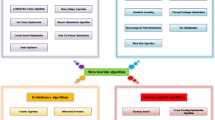Abstract
The directing orbits of chaotic systems is a common multimodal optimization problem in the engineering field. However, when this multimodal optimization problem is solved by evolutionary algorithm, it is difficult for the method to obtain the high-quality solution for easily falling into a local optimal solution. To address this concerning issue, a novel global gravitational search algorithm with multi-population mechanism (named GGSA) is proposed. GGSA makes use of the clustering method to divide the whole population into several subpopulations for maintaining the population diversity. Then, the information contained in global best agent is used to update the current agent for improving the convergence speed. By this way, the proposed algorithm can achieve a right tradeoff between the exploration and the exploitation. Finally, the directing orbits of discrete chaotic systems are used to test the performance of the proposed algorithm. The experimental results show GGSA has better performance than other compared methods.






Similar content being viewed by others
References
Zhang J (2015) On ground state and nodal solutions of Schrodinger–Poisson equations with critical growth. J Math Anal Appl 428:387–404
Pecora LM, Carroll TL (1990) Synchronization in chaotic systems. Phys Rev Lett 64:821–824
Sun H, Cao H (2008) Chaos control and synchronization of a modified chaotic system. Chaos Solit Fract 37:1442–1455
Jia Q (2008) Chaos control and synchronization of the Newton–Leipnik chaotic system. Chaos Solit Fract 35:814–824
Aguilar LR, Martinez GR (2007) Partial synchronization of different chaotic oscillators using robust PID feedback. Chaos Solit Fract 33:572-81
M F (2009) Sliding mode control and synchronization of chaotic systems with parametric uncertainties. Chaos Solit Fract 41:1390–1400
Chang WD (2009) PID control for chaotic synchronization using particle swarm optimization. Chaos Solit Fract 39:910–917
Hung ML, Lin JS, Yan JJ, Liao TL (2008) Optimal PID control design for synchronization of delayed discrete chaotic systems. Chaos Solit Fract 35:781–785
Mohammadi A, Zahiri S (2018) Inclined planes system optimization algorithm for IIR system identification. Int J Mach Learn Cybern 9:541–558
Korkmaz S, Babalik A, Kiran M (2018) An artificial algae algorithm for solving binary optimization problems. Int J Mach Learn Cybern 9:1233–1247
Liu B, Wang L, Jin YH, Hunag DX, Tang F (2007) Control and synchronization of chaotic systems by differential evolution algorithm. Chaos Solit Fract 34:412–419
Wang L, Li LL, Tang F (2004) Directing orbits of chaotic systems using a hybrid optimization strategy. Phys Lett A 324:22–25
Coelho LS, Bernert DLA (2009) An improved harmony search algorithm for synchronization of discrete-time chaotic systems. Chaos Solit Fract 41:2526–2532
Liu B, Wang L, Jin YH, Tang F, Hunag DX (2006) Directing orbits of chaotic systems by particle swarm optimization. Chaos Solit Fract 29:454–461
Rashedi E, Nezamabadi-pour H, Saryazdi S (2009) GSA: a gravitational search algorithm. Inf Sci 179:2232–2248
Rashedi E, Nezamabadi-pour H, Saryazdi S (2011) Filter modeling using gravitational searchal gorithm. Eng Appl Artif Intell 24:117–122
Mirjalilia S, Gandomi A (2017) Chaotic gravitational constants for the gravitational searchal gorithm. Appl Soft Comput 53:407–419
Li C (2017) Design of a fractional-order PID controller for a pumped storage unit using a gravitational search algorithm based on the Cauchy and Gaussian mutation. Inf Sci 396:162–181
Khatibinia M, Yazdani H (2018) Accelerated multi-gravitational search algorithm for size optimization of truss structures. Swarm Evol Comput 38:109–119
Zhang A (2018) A dynamic neighborhood learning-based gravitational search algorithm. IEEE Trans Cybern 48:436–447
Paskota M, Mees AI, Teo KL (1995) Directing orbits of chaotic dynamical systems. Int J Bifurc Chaos 5:573–583
Mallick S, Kar R, Mandal D, Ghoshal SP (2017) Optimal sizing of CMOS analog circuits using gravitational search algorithm with particle swarm optimization. Int J Mach Learn Cybern 8:309–331
Kennedy J, Eberhart RC (1995) Particle swarm optimization. In: Proceedings of the IEEE international 1st conference on neural networks; WA, Australia, pp 1942–1948
Ratnaweera A, Halgamuge SK, Watson HC (2004) Self-organizing hierarchical particle swarm opitmizer with time-varying acceleration coefficients. IEEE Trans Evol Comput 8:240–255
Zeng JC, Cui ZH (2005) Particle swarm optimizer with integral controller. In: Proceedings of the international 2005 conference on neural networks and brain, Beijing, pp 1840–1842
Cui ZH, Cai XJ (2009) Integral particle swarm optimization with dispersed accelerator information. Fund Inf 95:427–447
Cui LZ (2016) Adaptive differential evolution algorithm with novel mutation strategies in multiple sub-populations. Comput Oper Res 67:155–173
Li GH (2016) A novel hybrid differential evolution algorithm with modified CoDE and JADE. Appl Soft Comput 47:577–599
Cui LZ (2016) A novel artificial bee colony algorithm with depth-first search framework and elite-guided search equation. Inf Sci 367–368:1012–1044
Li GH (2017) Artificial bee colony algorithm with gene recombination for numerical function optimization. App. Soft Comput 52:146–159
Acknowledgements
This work was supported in part by the National Nature Science Foundation of China under Grant 61772391, Grant 61402534, Grant 71771208 and Grant 71271202, in part by Natural Science Basic Research Plan in Shaanxi Province of China under Grant 2018JQ6051 and Grant 2017JQ6059, in part by Young Talent fund of University Association for Science and Technology in Shaanxi, China, and in part by the Fundamental Research Funds for the Central Universities under Grants JB160708 and XJS18009.
Author information
Authors and Affiliations
Corresponding author
Additional information
Publisher's Note
Springer Nature remains neutral with regard to jurisdictional claims in published maps and institutional affiliations.
Rights and permissions
About this article
Cite this article
Huang, L., Qin, C. A novel modified gravitational search algorithm for the real world optimization problem. Int. J. Mach. Learn. & Cyber. 10, 2993–3002 (2019). https://doi.org/10.1007/s13042-018-00917-y
Received:
Accepted:
Published:
Issue Date:
DOI: https://doi.org/10.1007/s13042-018-00917-y




